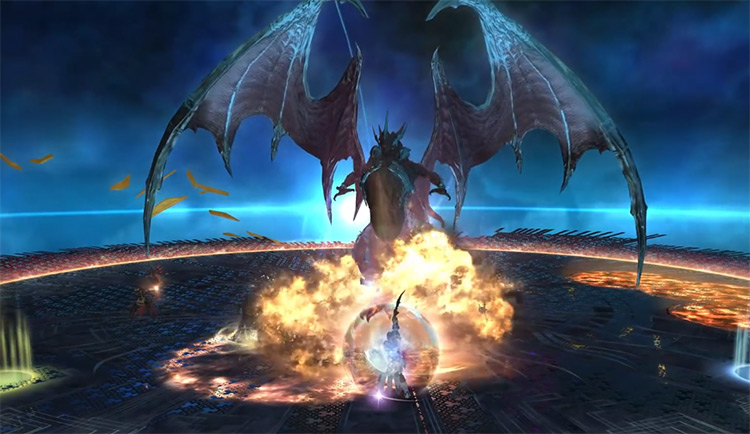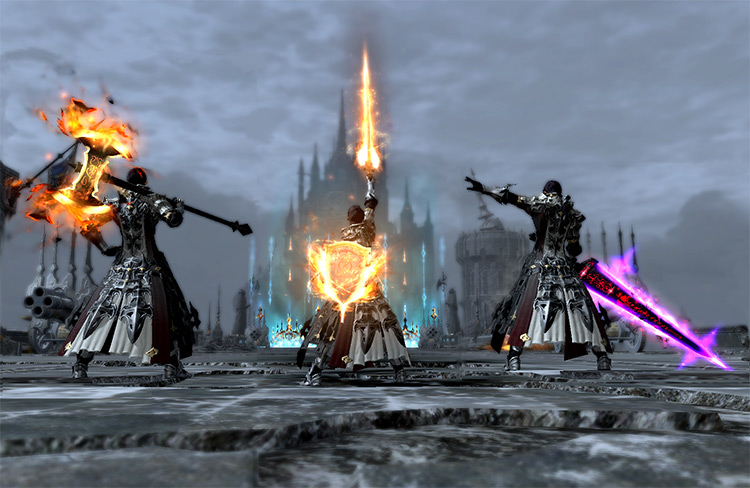But to clarify the terms, what’s the difference between “agro” and “enmity”? Short answer: they’re the same thing. Enmity, aggro, threat, or hate – these are all basically just words for the same thing. In any XIV fight, enmity will decide which character the bosses or mobs target with their attacks. Most of the time, the tanking player will be generating the most enmity, thanks to their tank stance and other effects. It’s very difficult to pull aggro away from a tank who knows what they’re doing. So for a lot of content, other players don’t even think about it that much.
How Do I Avoid Generating Enmity?
You don’t. You’ve just got to hope the tank is better at generating it than you! The actual number values of enmity are hidden from players, so we can’t really get into nitty-gritty analysis. But suffice to say that tanks will generate a lot more than other players, just by using their tank stance. There will still be times as a healer or DPS where you’ll get targeted by enemies. Maybe the tank missed one, or new mobs have joined the fight from behind. When this happens, don’t panic. Lead your hostile new friend into the tank’s position and they should hoover them up. For groups of more than two enemies, area of effect attacks are usually the standard. So they should quickly get clipped and refocus their attention on the tank. Typically, tanks won’t be moving around too much either. It’s easier for the party if there’s one designated spot for the fight, as DPS jobs usually have attacks that are more effective from certain positions. A tank might move to dodge AOE attacks, but will typically return to the same place afterwards. Lure enemies into this little killing field if you get too much enmity onto yourself. Good tanks will be keeping an eye on the situation as much as they can, making use of taunts to pull enemies back into their range. But that just isn’t possible all of the time. Even with all the cat ears and whatnot, we’re all human at the end of the day.
What Happens If I Have Too Much Enmity?
You’ll get repeatedly smacked in the face. This isn’t usually the end of the world if it’s a mob or two. It’s easy to redirect them to the tank even if they’re not paying attention. But if you’re fighting a boss, it could be slightly more problematic. Bosses hit harder than mobs, and have a much wider range of attacks. If you have too much enmity then you could find yourself on the receiving end of a tankbuster without the means to survive it. Tanks have much higher health and defense, alongside damage mitigation skills they can use to survive intense bursts of damage. So if a tankbuster hits a squishier player, it could just kill them outright. This is where tanks come in.
How Tanks Deal With Enmity
Generally speaking, a tank’s job is to get all the attention onto them. So it’s just par for the course. But if you’re in a dungeon and you find that you’re getting a bit more attention than usual (as a non-tank player), then it might be worth checking if the tank has remembered to put their tank stance on. This effect is cancelled when the game syncs player levels down to the content they’re doing, so it’s surprisingly easy to forget (God knows I’ve forgotten about fifty times). In the event the tank dies, whatever killed them will focus their attention on the player with the second highest enmity. This isn’t necessarily the bitter end, though, thanks to XIV’s relatively forgiving battle resurrections. In these situations, you’ve just got to do your best to keep the enemies as far away from the healer as possible until they can fire off a Raise spell.

